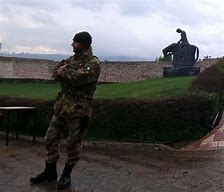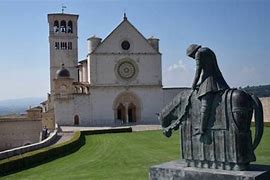
What is the man-in-the-street’s perception of St. Francis of Assisi? Is it one that is only shaped by the art that portrays him as soft and sweet, as just the saint of ecology and cuddly animals? Is he a man to be taken seriously only because of his love for nature? A “nice” non-threatening man willing to compromise and make everyone laugh and feel good?
Was St. Francis non-threatening? He never physically or psychologically threatened anyone. Yet, he did confront people with his profound belief and commitment to the Gospel message. He was as non-threatening as Jesus casting out demons, moneylenders, or the tricks and insults of the Pharisees. He was as non-threatening as our Savior confronting a rabid judgmental crowd and extending His hand to the woman caught in adultery.
Francis was a man who embodied the justice and mercy of Christ. His mission was to joyously proclaim the redemptive sacrifice of Jesus Christ, and explain how it directly applies to our lives.

St. Francis was not a rebel, revolutionary, or environmental reformer. He did not rail against the sinful imperfections and established order of the 13th century Church.
However, he certainly did challenge the established religious and social conventions of his day. He asked his fellow Italians: “Does your life reflect the life of Christ, and, if not why not?” He was not a social reformer but a reformer of the soul and spirit. He waged war, not against his neighbor and the Church, but against the sinful imperfections he perceived within his own mind, body and soul.
He did love nature, but only in reference to God. His love was not simply for the value and beauty of nature itself. He did not divinize nature. To do so is an attribute of paganism; it is heresy. He believed that the natural world, and all that is contained pointed to and is an indication of the Holy Trinity’s truth, goodness and beauty.
St Francis knew that the natural world is a reflection of the Lord’s creative diversity. It is a mirroring of His intimate action and the expression of His love. Do not trees, flowers, birds and wolves, and the entire cornucopia of plants an animals do this by their very existence? They follow God’s intimate plan by existing, living, and in their own unique way, proclaiming the glory of God.

How did he know this? As a sacred warrior he knew it because he was a man of the Scriptures and Sacraments. The Gospels and the Eucharist were his sword and armor; they were his rations, the “kit,” he needed to do battle on behalf of God.
He did not do battle with sin and the materialistic world in order to compromise the Catholic faith and have a “let’s all be religious buddies” attitude that promoted a watered down faith and a feel good theological commonality of “your god is my god.”
He did not disrespect others; yet, when he met with the Sultan during his mission to the Holy Land he did not venerate the Koran or say that other faiths and religious traditions had the truth about God. He did exactly the opposite; he confronted the imams with the challenge of the Gospel. Yes, he confronted them with the Truth, and they refused to accept it.
He was a committed and militant Roman Catholic. He did not condescend or lord it over others in the spirit of triumphalism. His tactics involved conquering his sins, his natural desires, and the “normal” perceptions of the world. His overall strategy was to model and convince others to give full belief, glory, and worship, not to the world, but to our Lord Jesus Christ. This could be accomplished by attending Holy Mass, receiving the Holy Eucharist with a clean soul, and applying Sacred Scripture to their lives
St. Francis, of course, did love his fellow man, but he was at war with his own sinfulness. He was a saint that exuded joy, yet, in the privacy of his own cell he shed tears over what he perceived as his own sins and failings. He commanded his brothers not to be sad and dejected in front of others, rather, to go to their own cells and there beg God for forgiveness and humility.
So why add the words “sacred warrior” to the many labels of a man and saint that cannot be labelled? When all is said and done, St. Francis of Assisi, as a warrior, vanquished himself. He overwhelmed his worldly desire for the honors of military service. He overcame his passions and distractions. He was victorious over the common day desires for wealth, position, power, and yes, even the great gift of the love of a wife and children. In its place he strapped on the humble sacred warriors garments of love for the Eucharist and the Holy Scriptures. Poverty, chastity, and obedience to God were his cincture.
The painting below shows the wounds in Francis’ hands and side. For his extraordinary witness to the love of God Jesus blessed him with the stigmata: an award, an honor, a medal far above anything that the world could provide.

Let us echo the words of St. Francis in his short prayer: Praise and thanks to Our Lord, Jesus Christ, “My God and my All.”
A profitable source for study are the authentic quotations compiled by Fr. James Meyer O.F.M. in his The Words of St. Francis – An Anthology (Franciscan Herald Press: Chicago, 1952). Meyer’s Anthology is backed up with sixteen different scholarly sources specializing in determining the actual words of St. Francis. It provides excellent insights through Francis’ words on poverty, chastity, obedience, prayer, and the rule that his brothers and sisters in Christ are to follow.
I have written about the virtues of St. Francis before, on October 4, 2012: https://fraangelicoinstitute.com/2012/10/04/the-virtues-of-st-francis-of-assisi-a-model-for-sacred-artists . I mention this not to sound a tinny trumpet and jangly bells but to request, if possible, the reader become familiar with it since it sets the stage for this post.
All photos were taken at Assisi, Italy. The Basilica is pictured behind the statue of St. Francis.
Copyright © 2011- 2021, Deacon Paul O. Iacono – All Rights Reserved. Permission to reprint must be obtained from the author in writing. Students, and those interested, may quote small sections of the article as long as the proper credit and notation is given. Thank you.

You must be logged in to post a comment.